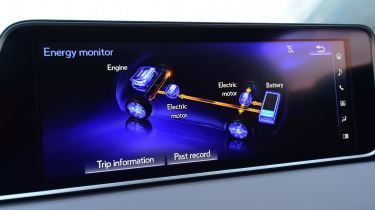What is a self-charging hybrid?
The term 'self-charging hybrid' appears often in the advertising and marketing of car manufacturers, but what exactly does it mean? Here, we outline the upsides, the downsides and the future of this technology

Over the last few years many car manufacturers have developed clever ways to reduce the emissions from their vehicles. For those not in the know, the way different brands refer to this tech can be very confusing. You've probably seen or heard the phrase 'self-charging hybrid' used by Japanese brands Lexus and Toyota for many years in advertising their electrified ‘hybrid’ cars, and more recently manufacturers such as Kia, Ford, Honda and Renault have adopted it, too. ‘Self-charging hybrid’ describes a type of hybrid car employing a petrol or diesel engine in combination with one or more electric motors and a small battery that never requires plugging in. This type of car is also known as a 'full hybrid'.
The battery is topped up using a combination of energy from the combustion engine and energy recovered from the car's brakes when it slows down. After a short spell of driving, the battery can transfer power to the electric motor, helping the car move along in traffic, when parking or if you hit the accelerator to gain speed, giving the engine a boost and saving fuel.
Unlike plug-in hybrid cars, self-charging hybrids don't offer the much full EV driving. The Kia XCeed PHEV plug-in hybrid can travel in electric mode for up to 36 miles, thanks to a 8.9 kWh battery. In contrast, a Renault Captur E-Tech self-charging hybrid features a smaller 1.2 kWh battery that can only support short bursts of pure-electric travel.
Unlike a plug-in hybrid, a self-charging hybrid like this cannot be recharged from a domestic socket or a public charging point. Normally, they can only drive for a mile or two at most on pure-electric power, but usually the idea is that short periods of electric running throughout a journey can add up to significant fuel savings overall. The smaller battery also means less weight, which also improves efficiency.
Self-charging hybrids shouldn't be confused with mild hybrid cars. Those are fitted with a starter generator instead of a starter motor. They're generally capable of idling without the engine on for longer in stop-start traffic, and in some cases can allow 'coasting' when cruising gently, where the car freewheels with the engine automatically switched off for brief periods. But they're not capable of electric-only driving for any distance. A 'self-charging' hybrid would be slightly more fuel efficient than an equivalent mild hybrid.
How do self-charging hybrids work?
Self-charging hybrids usually have one or more electric motors, which are used to boost the performance or efficiency of a car’s petrol or diesel engine. Nearly all self-charging hybrid models use a petrol engine. Once the battery has charged up sufficiently, a self-charging hybrid can use this additional energy to help the car gain speed, reducing the burden on the internal-combustion engine. This saves fuel, therefore improving fuel economy during typical trips within towns and cities.
Most self-charging hybrids are also capable of moving under electric power alone for short distances at lower speeds – most useful in slow-moving traffic and during manoeuvres like parallel parking. As well as conserving fuel, self-charging hybrids tend to have lower CO2 emissions than their purely petrol counterparts, making them somewhat better for the environment. Self-charging hybrids are so-named because you can't charge the battery externally via a cable: all the energy is harvested from either the engine, the brakes, or merely the act of slowing down.
In some self-charging hybrids – the Toyota Yaris, for example – you can choose how aggressively the car will decelerate the moment you take your foot off the accelerator. The more severe the setting, the more energy you'll recover to store in the battery. In some cases, this will allow you to drive without using the brake pedal at all – although you’ll still need to use it if you need to slow down suddenly or perform an emergency stop.
What are the benefits of a self-charging hybrid?
If you frequently drive in built-up areas or busy towns, self-charging hybrid technology reduces the workload on a petrol or diesel engine, reducing your running costs and air pollution. Self-charging hybrids usually emit less CO2 than their non-hybrid equivalents, which makes them more affordable as company cars. A car's Benefit-in-Kind (BiK) band is based on its CO2 emissions, with cleaner cars attracting lower rates.
Road tax (VED) is slightly lower for self-charging hybrids, at £180 a year instead of the £190 annual fee for conventional models. Hybrid vehicles are generally exempt from paying the London ULEZ (Ultra Low Emissions Zone) fee, but they became liable for the London Congestion Charge from October 2021, with only fully zero-emission cars now exempt. You may find that a self-charging hybrid could cost less to run than a plug-in hybrid, depending on how you use it. If you aren't able to charge a plug-in regularly, the battery effectively becomes dead weight, making a self-charging hybrid a better choice for some drivers.
Self-charging hybrids also cost less to buy than plug-in hybrids – often as much as £10,000 less – because their smaller battery packs are cheaper to produce. Many owners of full hybrid models also report lower maintenance costs, because the braking effect of the electric motor reduces wear on the brakes and tyres, helping them to last longer. Hybrid models like the Toyota Prius have proved to be very reliable, with fewer items like a clutch that need to be replaced.
Do self-charging hybrids have drawbacks?
While a self-charging hybrid is likely to be a better prospect for some drivers than a plug-in hybrid, it’s important to remember that their efficiency benefits are much reduced at motorway speeds. On fast roads, you're mostly reliant on the internal-combustion engine; if you travel cross-country a lot, then a pure petrol, diesel or longer-range electric car will probably be more suitable.
Because of their small batteries, self-charging hybrids can’t travel far on electric power alone; usually no more than a mile or two. So if you frequently drive short distances and you can charge at home or at work, a plug-in hybrid might be more cost-effective. Not only will you save money by using electric power rather than petrol or diesel, you’ll still have the option of driving further using conventional fuel should the need arise.
It's also worth noting that while there are a few four-wheel-drive SUVs available with the technology on board, these can't match their diesel equivalents for pulling power. A four-wheel-drive Toyota RAV4, for example, has a maximum braked capacity of 1,650kg, while most similarly sized diesel SUVs will manage around 2,000kg to 2,500kg. It's worth considering this if you're a caravan or trailer user.
Finally, self-charging hybrids are unlikely to suit driving enthusiasts. Most of them are designed to save fuel and make driving relaxing and pleasant, as opposed to exciting or involving. However, there are some fast hybrids out there if you really want the best of both worlds.
Will self-charging hybrids still be available after 2035?
As it stands you won’t be able to purchase a self- charging hybrid after 2035. This is due to the UK Government banning the sale of new combustion engined cars from that date with the aim to reduce emissions. There is a slight grey area with plug-in hybrid cars as they may be allowed to be sold after the ban if they are able to cover a 'significant distance' on electric power, but self-charging hybrids will be off the table for new car buyers.
Most Popular

EV Deal of the Day: Dacia Spring is amazingly good value at £116 per month


